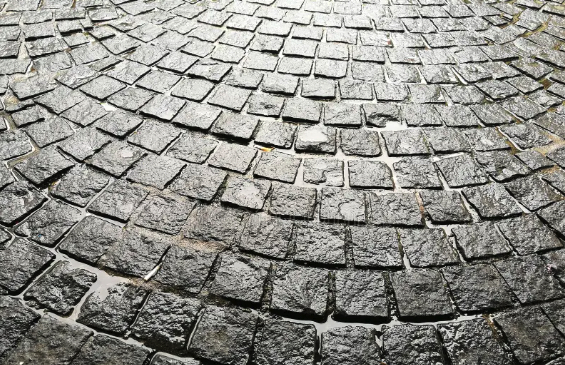Is Stamped Concrete Safe Around a Pool?

Stamped concrete has become popular for pool deck surfaces due to its versatility and aesthetic appeal. While it offers numerous benefits, it’s essential to consider safety when using stamped concrete around a pool area. In this guide, we will explore the safety aspects of stamped concrete for pool decks, highlighting its advantages and critical considerations.
The Appeal of Stamped Concrete for Pool Decks
Stamped concrete is a decorative concrete option that mimics the look of natural materials like stone, brick, or wood. It’s created by imprinting patterns and textures onto freshly poured concrete, resulting in a visually appealing surface. Here are some reasons why homeowners and pool designers often opt for stamped concrete:
1. Aesthetic Versatility:
Stamped concrete offers a wide range of design options. You can choose from various patterns, textures, and colors to match your pool’s style and the overall aesthetic of your outdoor space.
2. Durability:
When installed and maintained correctly, stamped concrete can be highly durable. It can withstand heavy foot traffic, pool chemicals, and environmental exposure.
3. Cost-Effective:
Compared to some other pool deck materials, stamped concrete can be a cost-effective choice, offering a luxurious appearance without the high price tag of natural stone or pavers.
4. Low Maintenance:
Stamped concrete is relatively easy to maintain. Regular cleaning and sealing can help preserve its appearance and extend its lifespan.
Safety Considerations for Stamped Concrete Around a Pool
While stamped concrete has its advantages, ensuring safety around the pool area is of utmost importance. Here are several safety considerations to keep in mind when using stamped concrete for your pool deck:
1. Slip Resistance:
One of the primary safety concerns around pools is slip resistance. Wet surfaces can become slippery, posing a risk of accidents and falls. To address this, stamped concrete can be treated with additives or sealers that enhance its slip resistance. Ask your contractor about options like textured finishes or slip-resistant coatings.
2. Proper Drainage:
Adequate drainage is crucial for preventing water accumulation on the pool deck. Poor drainage can lead to puddles, which not only pose a slipping hazard but can also damage the concrete over time. Ensure that your pool deck has adequate slope and drainage systems in place.
3. Sealing:
Regularly sealing your stamped concrete pool deck can help maintain its integrity and safety. Sealers not only protect the concrete from UV rays and pool chemicals but also reduce the risk of moisture penetration, which can lead to surface deterioration.
4. Heat Reflectivity:
In hot climates, the heat-absorbing properties of concrete can be a concern. Stamped concrete may become uncomfortably hot to walk on during scorching summer days. Consider using lighter-colored concrete or applying cool deck coatings that reflect heat.
5. Comfort and Texture:
The texture of the stamped concrete can impact comfort and safety. Some patterns and textures may be more comfortable underfoot and provide better slip resistance than others. Consider choosing a texture that is both visually appealing and practical for a pool deck.
6. Regular Maintenance:
Maintaining your stamped concrete pool deck is essential for safety. Regular cleaning to remove debris, algae, and other contaminants will help prevent slip hazards. Additionally, inspect the surface for any signs of wear, cracks, or damage, and address them promptly.
7. Surrounding Landscaping:
Landscaping elements, such as plants and trees near the pool, can drop leaves and create additional slip hazards. Regular landscaping maintenance can help keep the pool deck clean and safe.
8. Pool Barrier Compliance:
Depending on your location and local regulations, you may need to install safety barriers like pool fences or covers to prevent unauthorized access to the pool. Ensure that the installation of these safety features does not compromise the integrity or safety of the stamped concrete deck.
Hiring a Professional Contractor
To ensure the safety and longevity of your stamped concrete pool deck, it’s crucial to hire an experienced and reputable contractor. Here are some steps to consider:
1. Research:
Research local contractors who specialize in stamped concrete and have experience with pool deck installations. Check online reviews, ask for referrals, and view their previous work.
2. Credentials:
Verify that the contractor is licensed and insured. A professional contractor will have the necessary credentials to perform the job safely and to code.
3. Portfolio:
Review the contractor’s portfolio to assess the quality of their work and to see examples of stamped concrete pool decks they have completed.
4. Communication:
Engage in clear and open communication with the contractor. Discuss your safety concerns and ask about their plans for addressing them.
5. Contract:
Ensure that the contract includes all project details, including safety measures, materials, timelines, and costs. It should also outline maintenance requirements.
Conclusion
Stamped concrete can be a beautiful and practical choice for pool decks, offering a range of design options, durability, and cost-effectiveness. However, safety should always be a top priority when designing and maintaining your pool area.
To create a safe stamped concrete pool deck, consider factors such as slip resistance, proper drainage, heat reflectivity, and regular maintenance. By addressing these concerns and working with a qualified contractor, you can enjoy the aesthetic appeal of stamped concrete without compromising safety around your pool. A well-designed and well-maintained stamped concrete pool deck can provide a comfortable, inviting, and secure space for you and your guests to enjoy.




